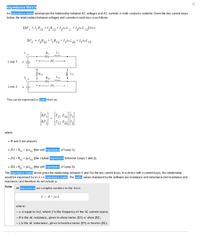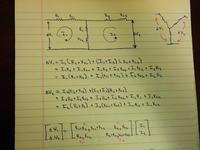jcesar203
Newbie level 2

Hello everybody,
Three conductors are being simulated in Maxwell with a peak current. From Maxwell I extract the impedance matrix (3x3 matrix) of the three conductors. Conductors are placed on top of each other so there will be mutual inductances and resistances. The documentation on the impedance matrix (2 by 2 matrix) from ANSYS is shown here:

3x3 example is not available.
How do you calculate the total resistance and reactance or impedance of a single conductor from the matrix? I was told you add R11 + R12 + R13 (same idea for reactance add across) to get total resistance of a conductor but I believe that is wrong. Reason is because you have two different currents I1 and I2 in these terms.
These conductors are being represented (Maxwell simulation) as 3 loops. Similar to what is shown in the documentation.
Here I derived (2x2 matrix only meaning 2 conductors) where each equation comes from and how the impedance matrix is built.

Now I believe the components in Z11 represent the total resistance and reactance of one conductor. Then Z22 represents the total values for the second conductor, and so on for n condcutors.
I cannot find a source to back this up. Does anyone know if what I defined is true? or provide a documentation based on calculating total impedance of a single conductor with mutual resistances and inductance? I cannot find anything online.
Thank you, and let me know if there are any questions.
Three conductors are being simulated in Maxwell with a peak current. From Maxwell I extract the impedance matrix (3x3 matrix) of the three conductors. Conductors are placed on top of each other so there will be mutual inductances and resistances. The documentation on the impedance matrix (2 by 2 matrix) from ANSYS is shown here:

3x3 example is not available.
How do you calculate the total resistance and reactance or impedance of a single conductor from the matrix? I was told you add R11 + R12 + R13 (same idea for reactance add across) to get total resistance of a conductor but I believe that is wrong. Reason is because you have two different currents I1 and I2 in these terms.
These conductors are being represented (Maxwell simulation) as 3 loops. Similar to what is shown in the documentation.
- The diagonal resistances are the self resistances due to DC component and skin effect as well as proximity effects. The off diagonal resistance is the result from proximity effect currents.
- The diagonal inductance are the self inductance of each coil and the off diagonal inductance are the mutual inductance due to coupling.
Here I derived (2x2 matrix only meaning 2 conductors) where each equation comes from and how the impedance matrix is built.

Now I believe the components in Z11 represent the total resistance and reactance of one conductor. Then Z22 represents the total values for the second conductor, and so on for n condcutors.
I cannot find a source to back this up. Does anyone know if what I defined is true? or provide a documentation based on calculating total impedance of a single conductor with mutual resistances and inductance? I cannot find anything online.
Thank you, and let me know if there are any questions.
Last edited by a moderator:
